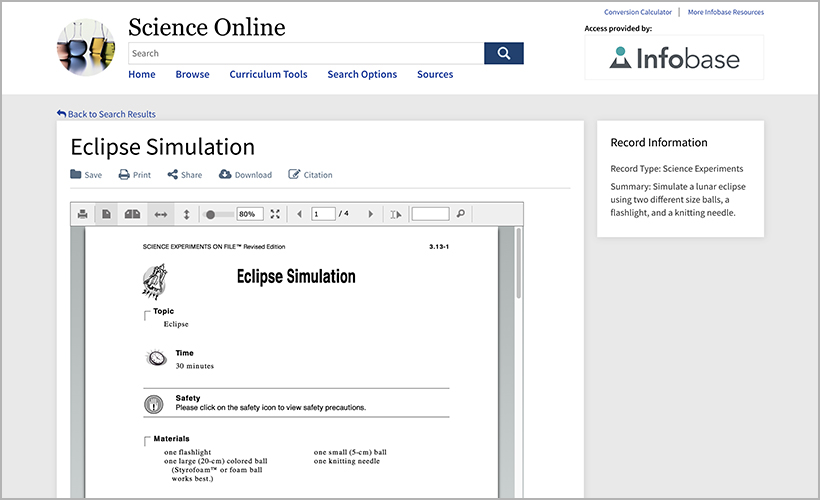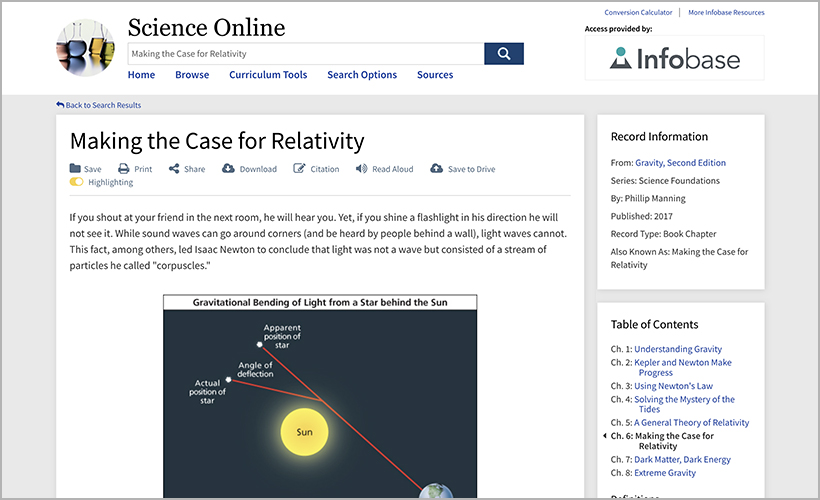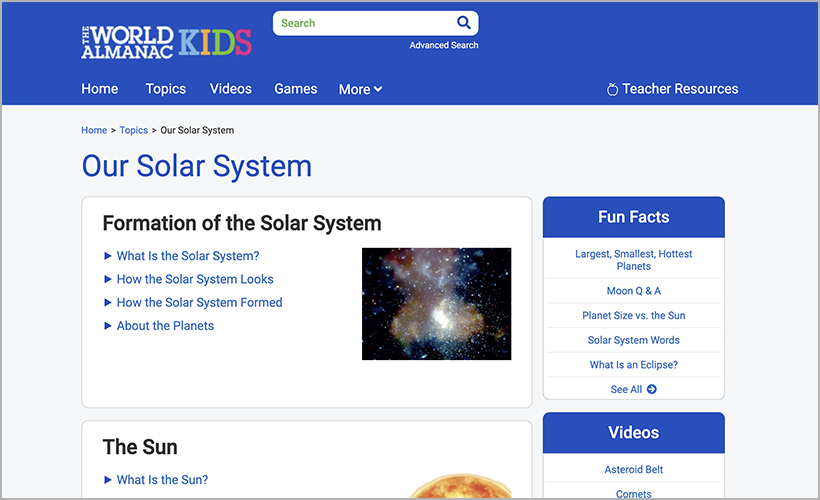Solar eclipses are exciting, often once-in-a-lifetime events that take place when the moon passes between the Sun and Earth. Whether you’re a science teacher using an eclipse as a teaching opportunity, a student putting together a research paper or science fair project on the topic, or a parent watching an eclipse with the kids, a solar eclipse in your community is an excellent time to brush up on the science behind the event. Turn to Infobase for the science content you need—including book and journal articles, images, experiments, and more—from sources you can always trust.
Science Online for STEM Research and Learning
The award-winning Science Online database contains a wealth of proprietary book and journal articles, images and videos, topic-specific timelines, tables and charts, and diagrams that provide a thorough grounding in all areas of the science curriculum, including content on or related to eclipses—from astronomy to the mysterious ways light works and bends. Some of the things you can find include:
Science Experiments
- Eclipse Simulation: In this experiment, learn how to simulate a lunar eclipse using two different size balls, a flashlight, and a knitting needle.
- Alhazen: Looking at Eclipses: Investigate the phenomenon of camera obscura, the result of external light passing through a small hole into a darkened room and projecting an outside image onto a surface in the room. (Includes historical information.)

Articles on Eclipses and the Theory of Relativity
- “Proving the Theory of Relativity” (from Theory of Relativity, Second Edition)
- “General Relativity” (from Encyclopedia of Physical Science, Revised Edition)
- “Making the Case for Relativity” (from Gravity, Second Edition)

Biographies of Scientists and Mathematicians Who Studied Eclipses
- Thales of Miletus (from The Birth of Mathematics, Updated Edition)
- Bhaskara II (from A to Z of Mathematicians, Updated Edition)
- Sir Frank Watson Dyson (from A to Z of Scientists in Space and Astronomy, Updated Edition)
- Sir Arthur Stanley Eddington (from A to Z of Scientists in Space and Astronomy, Updated Edition)
- Benjamin Banneker (from The Age of Genius, Updated Edition)
- Sir Joseph Norman Lockyer (from A to Z of Scientists in Space and Astronomy, Updated Edition)
- William Wallace Campbell (from A to Z of Scientists in Space and Astronomy, Updated Edition)
Encyclopedia Entries and Definitions for Relevant Terms
- Baily’s Beads
- Coronagraph
- Corona (earth science)
- Eclipse
- Grazing Occultation
- Occultation
- Penumbra
- Saros
- Shadow bands
- Sunspots
- Umbra
- And more!
Also, check out Science Online’s Space and Astronomy Topic Center, which brings together in one place specially selected content on astronomy—including editor-selected overview articles, suggested keyword searches, key videos and animations, printable experiments, diagrams, key tables and data, and a comprehensive topic timeline—to help students find a starting point for their research.
Today’s Science for Coverage of the Most Important Scientific Advances
Want to learn about scientific discoveries related to eclipses, but need content that’s broken down into language that’s easy to understand? Today’s Science can help. With Today’s Science, users will find articles with in-depth explanations of important advances in all of the major scientific areas, including space science.
High-Interest Science News Articles on Eclipses and the Sun
- When the Sun Goes Dark: The 2017 Solar Eclipse: In this article about the most recent total eclipse in the United States, learn more about the science behind eclipses, including how to watch one safely. (With a crossword puzzle.)
- Solar Eclipse: Lights Out Over China: In anticipation of China’s Olympic coming-out party in Beijing, nature provided a spectacular “night” show on August 1, 2008—a total solar eclipse. Learn about what happened.
- Solar Surfing: Exploring the Sun’s Atmosphere: In April 2021, NASA’s Parker Solar Probe became the first man-made spacecraft to cross into the Sun’s atmosphere. Learn more about the Alfvén surface and the Sun’s corona, which is only visible during eclipses.
- Homeric Astronomy—An Odyssey: In the classic Greek epic The Odyssey, did Homer describe an eclipse with the line, “The Sun has been obliterated from the sky, and an evil darkness invades the world”?
- And more!

Each Today’s Science article includes stunning videos, images, and diagrams that give students a front-row seat in a virtual scientific amphitheater. In addition, Today’s Science’s articles are linked to a bounty of related content such as crossword puzzles, cartoons, and questions; additional articles that help place news and discoveries in context; and Conversations with Scientists—engaging and insightful Q&As with today’s leading scientists that bring the research to life.
The World Almanac® for Kids and The World Almanac® for Kids Elementary for Our Young Astronomers
Many researchers past and present initially discovered their love of science from observing major astronomical events—including eclipses—firsthand. Many children who witness the eclipse will have lots of questions, so encourage that curiosity by starting them off with the best in reference for elementary and intermediate-level students.
Both databases include a short Fun Facts article entitled “What Is an Eclipse?” as well as “Modeling an Eclipse,” a science project teachers can use to reinforce a lesson about eclipses. Students can also find games, puzzles, and interactive worksheets on the solar system as well as biographies of famous and notable scientists, inventors, and mathematicians that may inspire them to take up careers in STEM themselves.
The World Almanac® for Kids Elementary
The World Almanac® for Kids Elementary provides a wealth of fun and educational elementary-level content—including engaging illustrated articles, videos, interactives, Fun Facts, and more—in a colorful, kid-friendly format organized by topic. Perfect for studying our solar system and the planets around us, The World Almanac® for Kids Elementary’s Solar System topic area features articles that teach students about the Sun and its relationship with the Earth. While they’re there, students will also discover in-depth, illustrated content on all the planets in our solar system—including Mercury, Venus, Earth, Mars, Jupiter, Saturn, Uranus, Neptune, and the dwarf planets including Pluto—plus phenomena like asteroids, comets, and meteors.

The World Almanac® for Kids
Each topic area in the award-winning The World Almanac® for Kids provides intermediate-level resources for homework, reports, and projects. For information on eclipses, direct students toward the Our Solar System topic area, where they can find an article about solar eclipses as well as articles on the Sun and the relationship between the Sun and Earth. Students will also discover articles on how the solar system was formed and about each of the planets, plus dwarf planets, asteroids, comets, and meteoroids.

Want to see these products for yourself? How about a FREE trial?
See also:



